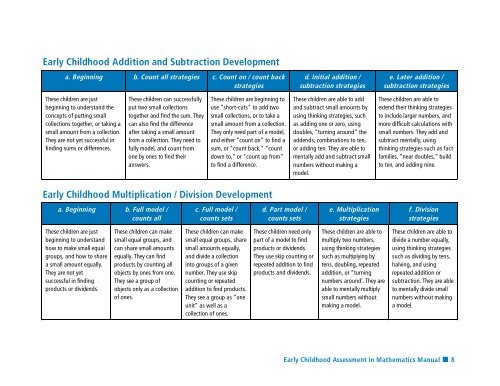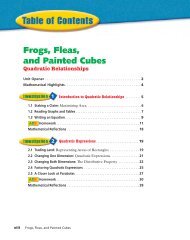ECAM-Manual-and-Resources
ECAM-Manual-and-Resources
ECAM-Manual-and-Resources
Create successful ePaper yourself
Turn your PDF publications into a flip-book with our unique Google optimized e-Paper software.
Early Childhood Addition <strong>and</strong> Subtraction Development<br />
a. Beginning b. Count all strategies c. Count on / count back<br />
strategies<br />
d. Initial addition /<br />
subtraction strategies<br />
e. Later addition /<br />
subtraction strategies<br />
These children are just<br />
beginning to underst<strong>and</strong> the<br />
concepts of putting small<br />
collections together, or taking a<br />
small amount from a collection.<br />
They are not yet successful in<br />
finding sums or differences.<br />
These children can successfully<br />
put two small collections<br />
together <strong>and</strong> find the sum. They<br />
can also find the difference<br />
after taking a small amount<br />
from a collection. They need to<br />
fully model, <strong>and</strong> count from<br />
one by ones to find their<br />
answers.<br />
These children are beginning to<br />
use “short-cuts” to add two<br />
small collections, or to take a<br />
small amount from a collection.<br />
They only need part of a model,<br />
<strong>and</strong> either “count on” to find a<br />
sum, or “count back,” “count<br />
down to,” or “count up from”<br />
to find a difference.<br />
These children are able to add<br />
<strong>and</strong> subtract small amounts by<br />
using thinking strategies, such<br />
as adding one or zero, using<br />
doubles, “turning around” the<br />
addends, combinations to ten,<br />
or adding ten. They are able to<br />
mentally add <strong>and</strong> subtract small<br />
numbers without making a<br />
model.<br />
These children are able to<br />
extend their thinking strategies<br />
to include larger numbers, <strong>and</strong><br />
more difficult calculations with<br />
small numbers. They add <strong>and</strong><br />
subtract mentally, using<br />
thinking strategies such as fact<br />
families, “near doubles,” build<br />
to ten, <strong>and</strong> adding nine.<br />
Early Childhood Multiplication / Division Development<br />
a. Beginning b. Full model /<br />
counts all<br />
c. Full model /<br />
counts sets<br />
d. Part model /<br />
counts sets<br />
e. Multiplication<br />
strategies<br />
f. Division<br />
strategies<br />
These children are just<br />
beginning to underst<strong>and</strong><br />
how to make small equal<br />
groups, <strong>and</strong> how to share<br />
a small amount equally.<br />
They are not yet<br />
successful in finding<br />
products or dividends.<br />
These children can make<br />
small equal groups, <strong>and</strong><br />
can share small amounts<br />
equally. They can find<br />
products by counting all<br />
objects by ones from one.<br />
They see a group of<br />
objects only as a collection<br />
of ones.<br />
These children can make<br />
small equal groups, share<br />
small amounts equally,<br />
<strong>and</strong> divide a collection<br />
into groups of a given<br />
number. They use skip<br />
counting or repeated<br />
addition to find products.<br />
They see a group as “one<br />
unit” as well as a<br />
collection of ones.<br />
These children need only<br />
part of a model to find<br />
products or dividends.<br />
They use skip counting or<br />
repeated addition to find<br />
products <strong>and</strong> dividends.<br />
These children are able to<br />
multiply two numbers,<br />
using thinking strategies<br />
such as multiplying by<br />
tens, doubling, repeated<br />
addition, or “turning<br />
numbers around’. They are<br />
able to mentally multiply<br />
small numbers without<br />
making a model.<br />
These children are able to<br />
divide a number equally,<br />
using thinking strategies<br />
such as dividing by tens,<br />
halving, <strong>and</strong> using<br />
repeated addition or<br />
subtraction. They are able<br />
to mentally divide small<br />
numbers without making<br />
a model.<br />
Early Childhood Assessment in Mathematics <strong>Manual</strong> ■ 8



